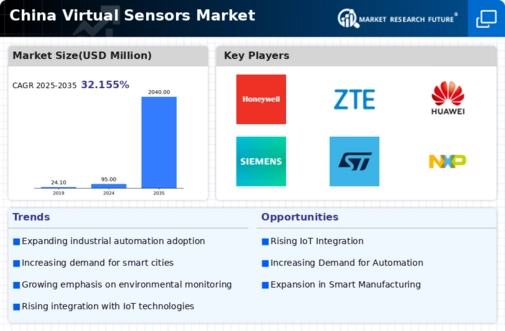Emergence of Smart Cities
The emergence of smart cities in China is a significant driver for the virtual sensors market. As urbanization accelerates, cities are increasingly adopting smart technologies to enhance infrastructure, improve public services, and promote sustainability. Virtual sensors play a crucial role in smart city initiatives by providing real-time data on traffic, air quality, and energy consumption. This data is essential for effective urban planning and management. As of November 2025, it is estimated that over 100 cities in China are implementing smart city projects, creating a substantial demand for virtual sensors. The investment in smart city infrastructure is projected to exceed $300 billion in the coming years, further fueling the growth of the virtual sensors market. This trend indicates a promising future for virtual sensors as they become integral components of urban development strategies.
Expansion of IoT Ecosystem
The expansion of the Internet of Things (IoT) ecosystem in China is a critical driver for the virtual sensors market. With the proliferation of connected devices and the increasing interconnectivity of systems, the demand for virtual sensors is expected to rise. These sensors play a vital role in collecting and transmitting data from various IoT devices, facilitating seamless communication and integration. As of November 2025, it is estimated that the number of IoT devices in China has surpassed 1 billion, creating a vast landscape for virtual sensors to thrive. This growth in the IoT ecosystem not only enhances operational efficiency but also enables innovative applications across sectors such as healthcare, transportation, and smart cities. Therefore, the virtual sensors market is likely to see substantial growth as businesses and governments invest in IoT infrastructure.
Increased Investment in R&D
In China, the virtual sensors market is benefiting from increased investment in research and development (R&D) across various industries. Companies are recognizing the potential of virtual sensors to enhance product quality and operational efficiency, leading to a surge in funding for innovative sensor technologies. The Chinese government has also been supportive of R&D initiatives, allocating substantial resources to promote technological advancements. As a result, the market for virtual sensors is projected to grow significantly, with estimates suggesting a potential increase of 30% in R&D spending over the next few years. This investment is likely to foster the development of more sophisticated virtual sensors, further driving their adoption in sectors such as manufacturing, automotive, and energy. The emphasis on R&D is expected to position the virtual sensors market as a key player in China's technological landscape.
Growing Focus on Data Analytics
The virtual sensors market in China is increasingly influenced by the growing focus on data analytics across various sectors. Organizations are recognizing the importance of data-driven insights for decision-making and operational improvements. Virtual sensors facilitate the collection of vast amounts of data, which can be analyzed to derive actionable insights. As businesses strive to enhance their competitive edge, the demand for advanced data analytics solutions is expected to rise. In 2025, the data analytics market in China is projected to reach approximately $20 billion, indicating a robust growth trajectory. This trend is likely to drive the adoption of virtual sensors, as companies seek to harness the power of data analytics to optimize processes and improve customer experiences. Consequently, the virtual sensors market is positioned to benefit from this increasing emphasis on data-driven strategies.
Rising Demand for Smart Manufacturing
The virtual sensors market in China is experiencing a notable surge due to the increasing demand for smart manufacturing solutions. As industries strive for enhanced efficiency and productivity, the integration of virtual sensors into manufacturing processes appears to be a key strategy. These sensors facilitate real-time monitoring and data analysis, enabling manufacturers to optimize operations and reduce downtime. According to recent estimates, the smart manufacturing sector in China is projected to grow at a CAGR of approximately 25% over the next five years. This growth is likely to drive the adoption of virtual sensors, as companies seek to leverage advanced technologies to remain competitive in a rapidly evolving market. Consequently, the virtual sensors market is poised to benefit significantly from this trend, as manufacturers increasingly recognize the value of data-driven decision-making.

















Leave a Comment